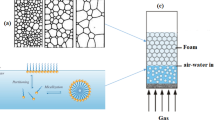Abstract
During autoclaving bacterial spores are probably inactivated by first order kinetics. An osmotically active control-mechanism is responsible for the thermoresistence of spores. Therefore the medium, that surrounds the spores during the autoclaving process, can influence the thermoresistence. At validation it appears that thermostabile solutions don't set problems. But thermolabile solutions can also be sterilised by the way of a germreducing technique (30 or 60 min at 100°C) when an in-process-control system is built up and high hygienic standards are fulfilled.
By integration of the so-called lethal-rates one can calculate the total lethality of the process and one can compare this value with the required lethality. The calculated lethality depends on the DT-and Z-values, that underly issues as FT Z-value, L-value and FO-value.
The required lethality depends on the DT-value and the bioburden (NO).
Samenvatting
Tijdens autoclavering worden bacteriele sporen waarschijnlijk volgens een eerste-orde reactie geïnactiveerd. Een osmotisch werkzaam regelmechanisme is verantwoordelijk voor de thermoresistentie van de sporen. Het milieu waarin de sporen zich bevinden kan daarom invloed uitoefenen op de thermoresistentie. Bij ‘validation’ blijkt dat thermostabiele stoffen een autoclaveringsproces goed kunnen doorstaan.
Thermolabiele stoffen blijken echter door een proces van kiemreductie te kunnen worden gesteriliseerd, wanneer tenminste wordt voldaan aan een volledige procesbeheersing. Door integratie van de zogenaamde letaliteitsfactor kan de totale letaliteit van een proces worden berekend en worden vergeleken met de vereiste waarde.
De berekende letaliteit is afhankelijk van de zogenaamde DT-en Z-waarden, die de basis zijn van begrippen als FT Z-waarde, L-waarde en FO-waarde. De vereiste letaliteit is afhankelijk van de DT-waarde en de initiële contaminatie (NO).
Similar content being viewed by others
Literatuur
Alderton, G., enN. Snell (1963)Biochem. Biophys. Res. Commun. 10, 139–143.
Berg, Th. M. (1980)Pharm. Weekblad 115, 133–142.
Bigelow, W. D. (1921)J. Infect. Diseases 29, 528–536.
Black, S. H., enP. Gerhardt (1962)J. Bacteriol. 83, 960–967.
Boom, F. A. (1978)Bacteriële contaminatie van infusievloeistoffen vóór sterilisatie, Utrecht, Ned. Ver. v. Ziekenhuisapothekers 11-2-1978.
Boom, F. A. (1980)Pharm. Weekblad 115, 170–181.
Boom, F. A., enA. C. A. Paalman (1979)Pharm. Weekblad 114, 157–165.
Cerf, O. (1976)J. Bacteriol. 42, 1–19.
Dring, G. J., enG. W. Gould (1975)Biochem. Biophys. Res. Commun. 66, 202–208.
Esty, J. R., enK. F. Meyer (1922)J. Infect. Diseases 31, 650–666.
Federal Register (1978) Part 211:Current Good Manufacturing Practice for finished Pharmaceuticals 43, 45077–45087.
Frieben, W. R., R. A. Kreiger, D. I. Juberg enR. M. Enzinger (1978)J. Parent. Drug Assoc. 32, 249–257.
Gould, G. W., enG. J. Dring (1975)Nature 258, 402–405.
Hugo, W. B. (1971) In:Inhibition and destruction of the microbial cell, Academic Press, London, 479.
Lewis, J. C., N. S. Snnell enH. K. Burr (1960)Science 132, 544–545.
Murrell, W. G., enW. J. Scott (1966)J. Gen. Microbiol. 43, 411–425.
Peled, O. N., A. Salvadori, U. N. Peled enK. K. Kedby (1977)J. Bacteriol. I29, 1648–1650.
Pflug, I. J. (1973)Heal sterilization. In:Industrial sterilization (Ed.)Philips, G. B., enW. S. Miller. Duke University Press, Durham, N.C., 239–282.
Polderman, J. (1977) In:De toedieningsvormen in de Ne-derlandse Farmacopee, Bohn, Scheltema en Holkema, Utrecht, 2–12.
Ross, K. F. A., enE. Billing (1957).J. Gen. Microbiol. 17, 418–425.
tromp, Th. F. J., Z. Nusman-Schoterman enT. Huizinga (1975)Pharm. Weekblad no, 485–492.
Wallhäuszer, K. H. (1978) Sterilisation, Desinfektion, Konservierung. Georg Thieme Verlag, Stuttgart, 204.
Author information
Authors and Affiliations
Rights and permissions
About this article
Cite this article
Tromp, T.F.J. Autoclavering; microbiologische aspecten. Pharmaceutisch Weekblad Scientific Edition 2, 142–149 (1980). https://doi.org/10.1007/BF02272963
Received:
Accepted:
Issue Date:
DOI: https://doi.org/10.1007/BF02272963




